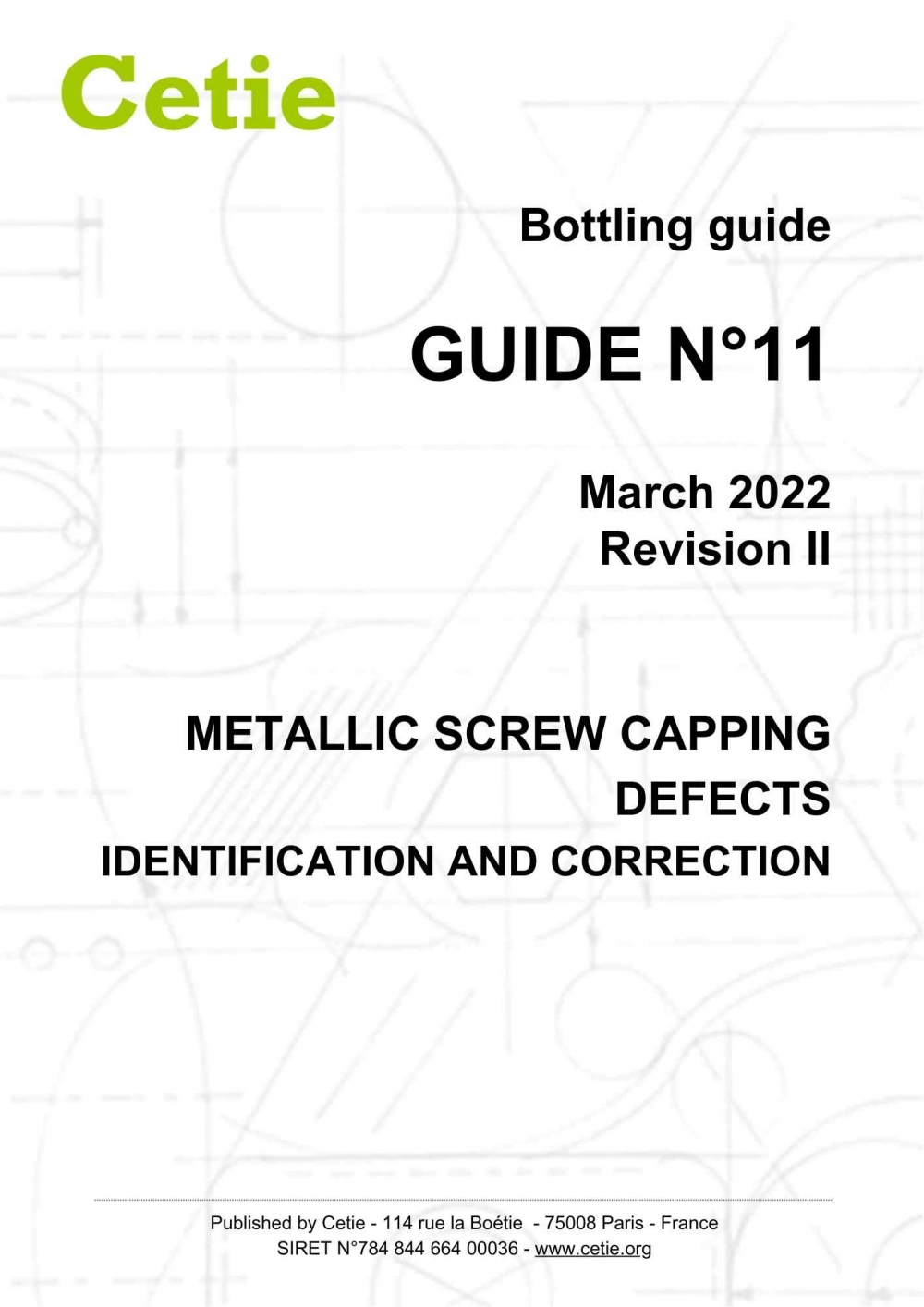Guide No.11
Revision II
Published on: 29/03/2022
Metallic screw capping defects - Identification and correction
Scope of application
This document identifies the principal defects that may occur with "Roll-On Pilfer-Proof" aluminium screw-type closures and outlines the methodology to orient corrective action. It applies to all different ROPP types for both still and pressurised liquids, with and without redraw, on glass finishes designed for this application (BVP, BVS, MCA, etc.).
The use of inserts (pourers, "non-refillable" devices) with BVP closures is partially covered by this guide.
The use of inserts (pourers, "non-refillable" devices) with BVP closures is partially covered by this guide.
Table of contents
1. Scope
2. Defects on supplies before capping
2.1 Defects on the bottle
2.1.1 Incorrect profile below the locking bead
2.1.2 Bulged finish
2.1.3 Rough sealing surface
2.1.4 Overpressed finish or high top
2.1.5 Split on the finish sealing surface
2.1.6 Line over finish
2.1.7 Sharp glass flash on finish mold seam
2. Defects on supplies before capping
2.1 Defects on the bottle
2.1.1 Incorrect profile below the locking bead
2.1.2 Bulged finish
2.1.3 Rough sealing surface
2.1.4 Overpressed finish or high top
2.1.5 Split on the finish sealing surface
2.1.6 Line over finish
2.1.7 Sharp glass flash on finish mold seam
2.1.8 Unfilled or incomplete finish
2.1.9 Defective sealing surface with a sharp edge
2.1.10 Broken bottle
2.2 Defect on the closure before capping
2.2.1 Damaged/Deformed / dented caps
2.2.2 Nested closures
2.2.3 Loose liner
2.2.4 Extra bridge
2.2.5 Surface defect on liner disk
2.2.6 Cut or incomplete liner
3. Defects observed after capping
3.1 Aspect of correctly applied capsules
3.2 Capping defects
3.2.1 Absence of thread
3.2.2 Shallow thread and tamper-evident profile, short thread
3.2.3 Thread start too low / cap marked at thread end
3.2.4 Poorly formed threads
3.2.5 Roller cut through at thread start
3.2.6 Roller cut through at middle of the thread
3.2.7 Skirt roller cut through at pilfer tuck (long skirt only)
3.2.8 Cut through at tamper-evident groove
3.2.9 Tuck ring not formed
3.2.10 Pull Off
3.2.11 Poorly formed crimping groove
3.2.12 Broken bridges – Short skirts
3.2.13 Broken bridges – Long skirts
3.2.14 Crushed bridges
3.2.15 Skewed cap
3.2.16 Closure sitting too high
3.2.17 Caps not transferring to bottles, or not settling on the finish
3.2.18 Spinner
3.2.19 High opening torque
3.2.20 Low opening torque
3.2.21 Liner cut through
3.2.22 Liquid or Gas escaping over time from cap/bottle interface
4. Quality control
5. Related documents
5.1 Standards
5.2 Cetie
5.3 Other references
6. Document history
7. Troubleshooting guide
Annexes
Annex A - Troubleshooting guide
Annex B – Contributors to Revision I
Index of figures
2.1.9 Defective sealing surface with a sharp edge
2.1.10 Broken bottle
2.2 Defect on the closure before capping
2.2.1 Damaged/Deformed / dented caps
2.2.2 Nested closures
2.2.3 Loose liner
2.2.4 Extra bridge
2.2.5 Surface defect on liner disk
2.2.6 Cut or incomplete liner
3. Defects observed after capping
3.1 Aspect of correctly applied capsules
3.2 Capping defects
3.2.1 Absence of thread
3.2.2 Shallow thread and tamper-evident profile, short thread
3.2.3 Thread start too low / cap marked at thread end
3.2.4 Poorly formed threads
3.2.5 Roller cut through at thread start
3.2.6 Roller cut through at middle of the thread
3.2.7 Skirt roller cut through at pilfer tuck (long skirt only)
3.2.8 Cut through at tamper-evident groove
3.2.9 Tuck ring not formed
3.2.10 Pull Off
3.2.11 Poorly formed crimping groove
3.2.12 Broken bridges – Short skirts
3.2.13 Broken bridges – Long skirts
3.2.14 Crushed bridges
3.2.15 Skewed cap
3.2.16 Closure sitting too high
3.2.17 Caps not transferring to bottles, or not settling on the finish
3.2.18 Spinner
3.2.19 High opening torque
3.2.20 Low opening torque
3.2.21 Liner cut through
3.2.22 Liquid or Gas escaping over time from cap/bottle interface
4. Quality control
5. Related documents
5.1 Standards
5.2 Cetie
5.3 Other references
6. Document history
7. Troubleshooting guide
Annexes
Annex A - Troubleshooting guide
Annex B – Contributors to Revision I
Index of figures
History
First edition : 02/2017
Revision I : 01/2021
Revision II : 03/2022
First edition : 02/2017
Revision I : 01/2021
Revision II : 03/2022
Contributors
ACTEGA DS GMBH, AMCOR FLEXIBLES CAPSULES, ARDAGH GERMANY, ARDAGH UK, ARDAGH UK, BV GLAS, CAPSULES TORRENTE, CLOSURE LOGIC, DAIM POLSKA, ENCIRC GLASS, VERALLIA FRANCE, GRACE (HENKEL ADHESIVE TECHNOLOGIES), GUALA, BACARDI, HERTI FRANCE, JGPC, MGJ, NESTLÉ WATERS, SAVERGLASS, SAZERAC, TORRENT CAPSULAS, VERALLIA FRANCE, VETROPACK, VINVENTIONS DEUTSCHLAND, WILLIAM GRANT & SONS, ZALKIN
Document under responsibility of working group:
Bottlers/fillers and glass manufacturers
WG chair: To be elected - -
This joint group aims to coordinate the production of documentation at the junction of the glass container production and bottling/filling. It includes good practices, the use and storage of glass containers, and quality management on bottling lines. This joint group also provides an opportunity for bottlers/fillers to open discussions on specific work items of the permanent glass groups
